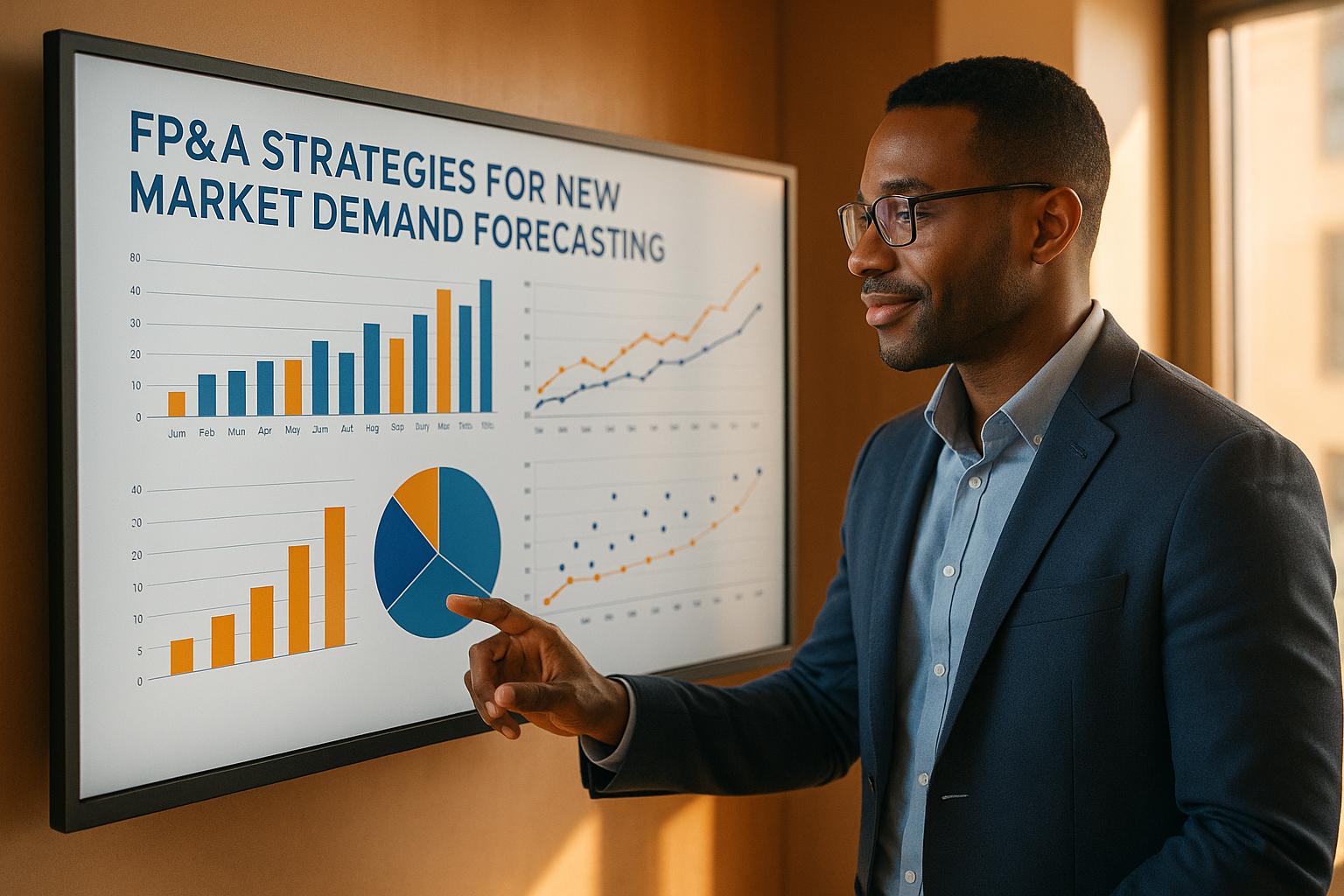FP&A Strategies for New Market Demand Forecasting

Expanding into a new market is tough, especially when you lack historical data to predict demand. Financial Planning and Analysis (FP&A) can help businesses make smarter decisions by turning data into actionable insights. Here's what you need to know:
- Why FP&A Matters: Poor demand forecasting costs businesses $1.77 trillion globally. FP&A helps allocate resources effectively, reducing risks and improving decision-making.
- Key Strategies:
- Collect data from market research, pilot tests, and surveys to understand market dynamics.
- Use external data and simple forecasting models when historical data is limited.
- Scenario analysis (best, worst, and base cases) helps prepare for uncertainty.
- Tech in FP&A: AI and machine learning improve forecast accuracy by analyzing complex data. Integrated FP&A platforms streamline collaboration and decision-making.
- Common Challenges:
- Limited historical data: Use expert panels, proxy data, and trial runs.
- Market volatility: Update forecasts frequently and focus on key drivers.
- Balancing cash flow: Align forecasts with budgets to avoid stockouts or excess inventory.
Core FP&A Strategies for New Market Demand Forecasting
Forecasting demand in new markets isn't as straightforward as relying on traditional methods. It requires a structured, strategic approach that can adapt to uncertainty while offering actionable insights. Below, we’ll explore the key strategies that can help you avoid costly missteps and improve the accuracy of your predictions.
Understanding Market Dynamics
To effectively plan for demand, start by assembling a cross-functional team that includes members from marketing, sales, operations, and technical roles. This diverse group ensures that insights from multiple perspectives are considered.
Begin with comprehensive data collection. Gather both qualitative and quantitative data from market research, pilot tests, and buyer surveys. Collaboratively analyze this information to establish essential assumptions - like the size of your target market, the percentage likely to purchase, expected purchase timelines, and patterns for repeat or replacement buying.
Broader economic factors also play a critical role in shaping market dynamics. Keep an eye on indicators such as GDP growth, inflation, interest rates, consumer confidence, and unemployment levels. At the same time, consider evolving trends, such as shifts in consumer preferences, new product launches, advancements in technology, and the growing demand for customization and eco-friendly options.
"I worked with a local HVAC/plumbing/electrical firm that used predictive analysis (historical data) and customer service experiences gleaned from company service technicians' customer interactions to estimate future service needs. Their experience has shown that using both of these methods has provided valuable service staffing level estimations and customer appointment time preferences. Another client has both traditional and online retailing operations. The online presence is relatively new so we were unable to use historical data. As an alternative, we used in-store and website customer surveys to rank order online purchasing preferences (free shipping and free returns dominated other preferences) to estimate online purchasing demand."
– Dr. Bob Wood, Professor of Finance at University of South Alabama
Don’t overlook seasonal and cyclical patterns. Even in new markets, demand often follows predictable fluctuations throughout the year. Incorporating these trends into your analysis helps account for natural variations.
Lastly, compare your forecasts to similar products already in the market. This can help you estimate market share changes as competitors enter the space. Studying the sales trajectory of comparable products also provides a reality check for your assumptions. Remember, about 80% of new products fail, so having realistic expectations is critical for success.
Building Data-Driven Forecasting Models
Once you have a strong grasp of market drivers, the next step is to create reliable forecasting models. When historical data is limited, external data sources are invaluable. Use industry benchmarks, market research, customer surveys, and data from similar businesses to fill in the gaps. External factors like weather, social media trends, and economic indicators can also improve forecast accuracy.
For limited datasets, opt for simpler machine learning models. For example, K-Nearest Neighbors regression is a good choice because it doesn’t rely on strict assumptions and can handle outliers well. In some cases, combining multiple models - where simpler ones handle smaller datasets and more advanced models process larger sets - can yield better results.
"To obtain the most accurate forecasts you'll want to combine them. Common methods include: blending all available data as inputs of a single forecasting model (e.g., historical sales, marketing trends, customer survey, economic metrics…) or using several models and consider the average of the different results as your demand forecast. In any case, the best way to select a method will be to apply it to historical data and compare results."
– Arthur Pentecoste, Data scientist and author of Demand Prediction in Retail
Data enhancement techniques can help make the most of limited information. For instance, data-smoothing and augmentation can reduce noise in time-series data, especially during unusual periods. Rigorous cleaning and validation processes are essential to address missing values, outliers, and inconsistencies.
Feature engineering is another powerful tool. Create new variables like seasonality indicators, lagged variables, or promotional event markers to help your models detect hidden patterns. Additionally, ensure your models are detailed enough to reflect differences across market segments, geographic areas, and pricing tiers. This level of granularity allows for more precise inventory and resource planning.
Using Scenario Analysis
Scenario analysis is a valuable tool when entering new markets, especially when traditional forecasting methods fall short. It allows you to prepare for a range of possible outcomes, making it easier to navigate uncertainty. Despite its benefits, Vena's 2022 Industry Benchmark Report found that 55% of companies don’t use scenario analysis when adjusting forecasts - a missed opportunity to improve decision-making.
Start by defining three key scenarios: the base case (most likely outcome), the worst case (a conservative view accounting for risks), and the best case (an optimistic scenario). For each scenario, build separate financial models and analyze their impact on critical metrics like revenue, costs, and cash flow.
Pay special attention to variables that are crucial for success in the new market. These might include sales growth rates, revenue projections, overhead costs, and the cost of goods sold. In unfamiliar markets, exploratory scenarios can help you anticipate sudden shifts that might significantly affect demand.
Real-world examples highlight the power of scenario analysis. In the 1970s, Shell used this approach to prepare for oil price volatility, gaining a competitive edge during the 1973 oil crisis. Similarly, UPS has used scenario planning since the late 1990s to adapt to global trade changes, optimizing its logistics and expanding operations in response to market shifts.
The true value of scenario analysis lies in integrating it into decision-making. Use it to stress-test strategies, identify potential risks, and take proactive steps. Regularly update your scenarios as conditions change, such as after earnings reports or major economic developments.
Combining data-driven insights with human expertise is essential for effective scenario analysis. When data is ambiguous or incomplete, expert intuition can help identify emerging trends and opportunities that might otherwise go unnoticed. Encourage collaboration across teams - sales, marketing, operations, and finance - to enhance the relevance and accuracy of your scenarios.
Using Technology in FP&A
Expanding on foundational strategies, modern technology is reshaping FP&A (Financial Planning and Analysis), especially when it comes to forecasting demand in unfamiliar markets. Tools powered by artificial intelligence, machine learning, and cloud platforms are making it possible to generate insights that were once out of reach with traditional methods.
AI and Machine Learning in Forecasting
Artificial intelligence and machine learning have brought a new level of precision to demand forecasting. These technologies address the limitations of older methods by analyzing complex factors that influence demand, even in fast-changing markets.
"AI deploys advanced models such as neural networks and deep learning to capture intricate, nonlinear drivers of demand. These models are useful when historical data is limited, such as a new product launch or entry into an unfamiliar market. This ability to 'predict the unpredictable' distinguishes AI from traditional forecasting methods, which usually falter without long data histories."
– IBM
The impact of AI-driven demand forecasting is striking. Companies that adopt these tools often see forecast errors drop by 30% to 50%. Stockouts, which lead to lost sales, can decrease by as much as 65%, while inventory levels may shrink by 20% to 50%, freeing up working capital.
AI systems excel at processing enormous datasets from sources that traditional methods struggle to handle. These include IoT devices, social media sentiment, economic trends, weather patterns, customer loyalty data, website analytics, product reviews, shipping delays, and geopolitical events. By analyzing these inputs, AI uncovers complex patterns that might otherwise go unnoticed.
Real-world success stories highlight the potential of AI forecasting. For example, Procter & Gamble's AI-based system in Japan aims to reduce its delivery truck fleet by 30%, cutting transportation costs and emissions. Lenovo's Supply Chain Intelligence (SCI) taps into over 800 data sources, achieving a 4.8% revenue increase, a 5% boost in on-time deliveries, and nearly 20% reductions in manufacturing and logistics costs. Walmart, during the COVID-19 pandemic, used machine learning to adjust forecasts in real time, factoring in weather, local events, and shifting consumer behavior.
"The latest ML algorithms can detect subtle shifts in consumer sentiment that precede actual purchasing behavior changes by weeks or even months."
– ToolsGroup
Machine learning models continuously refine their predictions, adapting to changing conditions. They can distinguish between demand created by promotions and natural growth, offering a clearer picture of ROI. Advanced models even generate SKU-level forecasts by grouping products, customers, and locations with similar demand patterns. These insights are vital for creating integrated FP&A systems that drive better decision-making.
Integrated FP&A Solutions
Cloud-based FP&A platforms have transformed how finance teams collaborate and make decisions. By consolidating data from ERP, CRM, HRIS, and spreadsheets into a single source of truth, these platforms eliminate the silos that often hinder traditional planning methods.
Switching from error-prone spreadsheets to integrated platforms enhances forecast accuracy and improves collaboration.
"Modern FP&A software holds the answer to reducing errors, increasing accuracy, and integrating data in a secure and collaborative environment."
– Acterys
Integrated FP&A tools bring critical capabilities to the table, especially for forecasting in new markets. Real-time data integration ensures that forecasts are always up-to-date, while advanced budgeting and scenario analysis tools allow businesses to explore multiple outcomes. By unifying financial and operational data, these platforms provide the precision needed for market entry decisions.
Features like scenario modeling enable companies to test assumptions about market adoption, competitive reactions, and pricing strategies. Collaboration tools further streamline workflows, aligning finance, sales, marketing, operations, and HR around shared financial data.
"Modern FP&A isn't just about better numbers; it's about better collaboration."
– Kyanusch Kay, VP of FP&A and Performance at Jedox
Driver-based planning connects demand and supply factors to financial models, creating realistic revenue and cost forecasts - particularly valuable when historical data is limited. Rolling forecasts, spanning 12–18 months, offer continuous visibility, allowing businesses to adapt quickly to new challenges or opportunities. For instance, Unilever's connected planning platform, launched in April 2025, integrates finance with supply chain, marketing, and sales. This setup enables swift responses to market disruptions and optimizes working capital.
Tools and Services from Phoenix Strategy Group

To fully utilize these technological advancements, businesses can turn to experts like Phoenix Strategy Group. They provide specialized tools and services tailored to streamline FP&A processes for companies entering new markets. By blending advanced technology with financial expertise, they deliver comprehensive solutions for demand forecasting.
Their Fractional CFO services cover FP&A, strategic finance, forecasting, and budgeting - key components for accurate demand forecasting. This option gives growing companies access to senior-level expertise without the expense of a full-time hire.
Data engineering is another cornerstone of their approach. Phoenix Strategy Group builds ETL pipelines, data warehouses, and analytics dashboards to handle the large datasets essential for precise forecasting.
"As our fractional CFO, they accomplished more in six months than our last two full-time CFOs combined. If you're looking for unparalleled financial strategy and integration, hiring PSG is one of the best decisions you can make."
– David Darmstandler, Co-CEO, DataPath
Their integrated financial models process company data, generate critical metrics, and create tailored forecasts aligned with growth strategies. They also ensure that KPIs are consistent across departments, which is crucial for seamless coordination between sales, marketing, operations, and finance.
Phoenix Strategy Group’s approach includes weekly forecast reviews and updates to adapt to changing market conditions. With internal data scientists, they apply advanced analytics to deliver sophisticated forecasting solutions.
"Hire PSG if you want to make your life easier and have accurate data."
– Michael Mancuso, CIO, New Law Business Model
sbb-itb-e766981
Solving Common Challenges in New Market Demand Forecasting
Even with advanced forecasting models, entering new markets comes with its own set of hurdles that can throw off strategies. By combining expert insights with well-structured forecasting frameworks, businesses can navigate these challenges more effectively. Let’s explore some of the most common obstacles and practical ways to tackle them, starting with the issue of limited historical data.
Managing Limited Historical Data
One of the toughest challenges in forecasting demand for a new market is the lack of reliable historical data. Without past numbers to guide predictions, businesses must rely heavily on expert judgment and market intelligence.
In such cases, qualitative methods take center stage. The Delphi Method, for example, has shown impressive results. By gathering insights from panels of experts, companies have achieved forecasts that align with actual sales by as much as 97%. Tools like customer surveys and focus groups also help uncover key factors like preferences, price sensitivity, and buying behavior, all of which are essential for building demand estimates.
"Human forecasters are able to use contextual data to inform their judgment, something that purely quantitative models are not capable of if the context is not represented in the dataset. Also, humans tend to outperform the accuracy of quantitatively generated forecasts if data are sparse."
- National Center for Biotechnology Information
Another strategy is to use proxy data. By analyzing similar product categories, comparable market launches, or analogous customer segments, businesses can establish a baseline for their forecasts. Trial runs in specific regions can further validate these estimates, creating initial sales data while minimizing risk. Pre-orders are another effective way to measure genuine demand while generating early revenue.
The key is to combine multiple approaches. Start with expert panels to define broad parameters, then verify those findings through customer research and limited market trials. As actual data starts coming in, incorporate quantitative methods to refine and enhance forecasts.
Adapting to Market Volatility
New markets are often unpredictable, with sudden changes in consumer behavior, competitive moves, or economic conditions. In such environments, being flexible matters more than being perfectly precise.
Driver-based forecasting is a useful tool here. By linking financial outcomes to key variables - like marketing spend, economic trends, pricing, and competitor actions - businesses can quickly adjust their forecasts as conditions shift.
"The mark of a great model is that it's not an oracle. Instead, a best-in-class forecast presents actionable insights by being transparent, consistent, and ever-improving. Projections need to be flexible and quickly adaptable."
- McKinsey
Short-term forecasting cycles also help businesses stay nimble. Weekly or bi-weekly updates allow companies to react quickly to new information. During critical launch periods, some businesses even reforecast daily, treating it as an ongoing process rather than a one-time task.
Granular modeling adds another layer of adaptability. By analyzing how different regions, customer segments, or price points respond to changing conditions, businesses can pinpoint what’s working and what needs to be adjusted.
Rather than aiming for perfect predictions, focus on regular updates and backtesting. Comparing forecasts to actual outcomes helps identify patterns and improve accuracy over time. And since market volatility can directly impact cash flow, aligning financial management with updated forecasts is crucial.
Balancing Cash Flow and Investment
Breaking into a new market often requires significant upfront investment, all while cash flow remains uncertain. Poor demand forecasting can lead to serious cash flow issues - either running out of stock or tying up capital in excess inventory.
The stakes are high: 93% of sales leaders fail to forecast revenue within a 5% margin, even with just two weeks left in the quarter.
"Positive cash flow indicates that a company's liquid assets are increasing, enabling it to cover obligations, reinvest in its business, return money to shareholders, pay expenses, and provide a buffer against future financial challenges."
- Investopedia
To avoid these pitfalls, integrate financial planning with demand forecasts. Aligning supply, demand, and accounting projections ensures production schedules, inventory levels, and marketing budgets are based on realistic expectations - not overly optimistic guesses.
Accurate demand forecasts help maintain the right stock levels, reducing the risk of shortages or overstocking. Detailed budgets that account for different demand scenarios can further safeguard against surprises.
It’s also wise to keep cash reserves on hand for unexpected challenges. Frequent updates to forecasts allow businesses to adjust production, marketing, and inventory strategies based on real-world performance.
Conclusion: Building Strong FP&A Frameworks for New Market Success
Successfully forecasting demand in new markets hinges on a well-structured FP&A framework that combines strategic planning, accurate forecasting, and cutting-edge technology. Companies that embrace these structured financial planning approaches consistently outpace those sticking to outdated methods.
The most effective forecasting strategies pull from multiple data sources and methodologies. With up to 90% of business data being unstructured, tools like AI and machine learning have become indispensable for turning raw data into actionable insights.
"A good model is one that helps us think about a business and make operational decisions by understanding their financial impact."
- Taylor Davidson, Founder of Foresight
FP&A is undergoing a major transformation, shifting from traditional reporting to becoming a strategic driver in decision-making. This shift is especially crucial for businesses entering new markets, where agility and informed decisions can make or break success.
"FP&A's role is no longer just reporting what's already happened. It's now generating insights that support CFOs in long-term value creation."
- EY Americas
This evolution isn’t just theoretical - it delivers real results. A prominent construction and machinery manufacturer that integrated AI, machine learning, and robotic process automation into its FP&A processes saw forecast accuracy improve by 10-12%, while cutting forecasting costs by 60%. These technologies are proving to be game-changers in tackling challenges like market volatility, limited historical data, and cash flow management.
A strong FP&A framework addresses these challenges holistically. By combining scenario planning, driver-based forecasting, and adaptable update cycles, companies build resilient systems that can pivot as market conditions shift. For growth-stage businesses, partnering with seasoned FP&A professionals can accelerate this process. For example, Phoenix Strategy Group blends advanced technology with deep financial expertise to help companies enhance their forecasting capabilities while maintaining the cash flow discipline needed for sustainable growth.
Investing in a robust FP&A framework gives businesses a real edge in competitive markets. In new market ventures, this edge can be the deciding factor between success and failure. By improving forecast accuracy and equipping teams with the financial intelligence needed for confident decision-making, companies position themselves to thrive in uncertain and evolving markets. Streamlined FP&A practices are no longer optional - they’re essential for navigating new challenges and driving long-term growth.
FAQs
What are the best strategies for forecasting demand in new markets with little to no historical data?
Forecasting demand in new markets without much historical data can feel like navigating uncharted waters. But there are strategies that can help businesses make informed predictions.
One approach is to use qualitative methods like gathering expert opinions, conducting market research, and running consumer surveys. These tools provide valuable insights into potential demand, especially when there's no reliable historical data to lean on.
Another useful tactic is studying industry benchmarks and analyzing competitor performance. This can reveal trends and patterns that serve as a guide for your forecasts. Incorporating real-time data and using predictive analytics can further sharpen your estimates, allowing you to adjust quickly as new data comes in.
By blending these techniques, businesses can develop demand forecasts that are both flexible and grounded, even in markets where the path forward isn’t entirely clear.
How do AI and machine learning improve demand forecasting for businesses entering new markets?
AI and machine learning are transforming demand forecasting by processing historical and real-time data to generate highly precise predictions. This capability enables businesses venturing into new markets to better anticipate demand patterns, minimize forecasting errors, and streamline supply chain operations. The result? Improved efficiency and stronger profitability.
By automating intricate data analysis, these technologies also help companies quickly respond to shifting market dynamics. This not only enhances decision-making but also bolsters strategic planning, equipping businesses to tackle market challenges and seize emerging opportunities with confidence.
How can FP&A teams use scenario analysis to prepare for market uncertainty?
Scenario analysis provides FP&A teams with a structured way to tackle market uncertainty by modeling best-case, worst-case, and most-likely scenarios. By examining how these different outcomes affect critical financial metrics - like revenue, expenses, and cash flow - businesses can pinpoint potential risks and uncover opportunities ahead of time.
This method strengthens strategic planning by enabling teams to test various market conditions and develop contingency plans. In turn, companies can respond more effectively to market shifts, staying flexible and prepared to handle volatility in both emerging and changing markets.




